p.120
p.124
p.128
p.133
p.137
p.144
p.148
p.152
p.157
Characterization of Anti-Cancer Drug Materials Loaded Poly(3-hydroxybutyrate-co-3-hydroxyhexanoate) Microspheres for Drug Delivery System in Biochemical Material System
Abstract:
Poly (3-hydroxybutyrate-co-3-hydroxyhexanoate) (PHBHHx) is one of the components of polyhydroxyalkanoates (PHAs) and some of its mechanical properties have been shown to improve over poly (3-hydroxybutyrate) (PHB) and poly (3-hydroxybutyrate-co-3-hydroxyvalerate) (PHBV). The investigation of PHBHHx microspheres as a drug delivery system was prepared by emulsion-solvent evaporation method for the sustained release of anti-cancer drug 5-fluorouracil (5-FU) and cyclosporin A (CsA). The mean diameter of the PHBHHx microspheres ranged from 5.24 to 22.10 μm dependent on the different processing parameters. The PHBHHx concentration, emulsifier concentration, anti-cancer drug dosage, and agitation speed, were optimized according to the encapsulation efficiency of 4% PHBHHx, 0.5% SDS, 10 mg anti-cancer drug, and 500 rpm. Under optimized conditions, the encapsulation efficiency of 5-FU and CsA microspheres were 7.19% and 96.44%, respectively. The morphologies of scanning electron microscope (SEM) suggested that PHBHHx microspheres were relatively smooth that provided better dispersion compared to PHB microspheres. The in vitro release profiles indicated 32.42% of 5-FU and 30.61% of CsA were released from PHBHHx microspheres during the initial burst phase, and the drug release from PHBHHx microsphere could be detected even after one month. The characteristics of PHBHHx microspheres demonstrated the feasibility of PHBHHx microsphere as a novel matrix for drug release system. With positive maintenance of the therapeutic concentrations of the drug, side effects can be reduced and patient compliance can be improved.
Info:
Periodical:
Pages:
137-143
Citation:
Online since:
November 2012
Authors:
Price:
Сopyright:
© 2012 Trans Tech Publications Ltd. All Rights Reserved
Share:
Citation:


